Maine is home to a wide variety of nonmigratory and migratory species of birds. Now that it is almost the middle of July, we have been enjoying our resident species and the arrival of many new bird species for the season, as well as sightings of their offspring. In this post, I would like to share a few photographs of the species of birds that I have seen. I will also include some migration and breeding information about them. These will be divided into two sections, nonmigratory and migratory species.
Nonmigratory Species
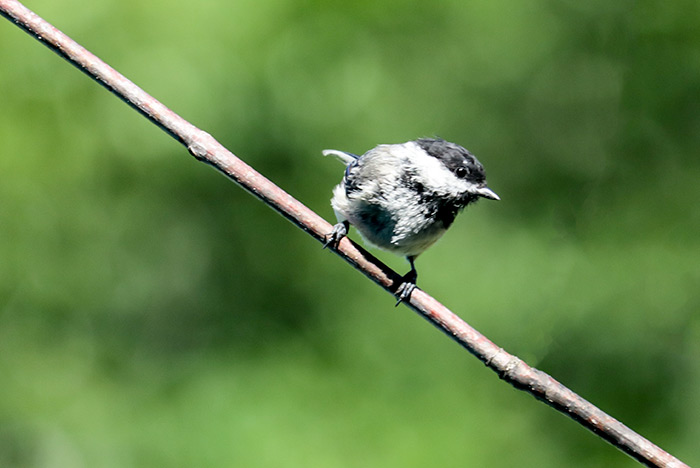
Black-capped chickadees Poecile atricapillus, will usual breed once a year, but a second time is possible if the first one doesn’t survive. The female will choose and build the nesting site in dead or rotten branches of alder or birch trees. The nesting site may be in other natural cavities, abandoned woodpecker cavities, or nest boxes. The nesting season is from late April through June. Clutch size consists of six to eight eggs, that are white in color with fine dots of reddish brown concentrated at the larger end.

Tufted titmice Baeolophus bicolor, will use a hole in a tree, a natural cavity, nesting boxes, or an old woodpecker nest for nesting sites. Eggs are under an inch long and are white in color or cream with brown or pink spots. Clutch size averages around five to seven eggs. Offspring will often remain with their parents through the winter and after the first year.
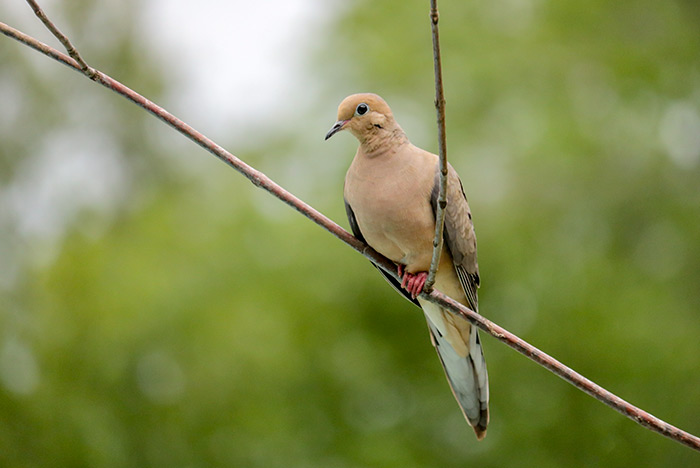
Mourning doves Zenaida macroura, will often nest in either deciduous or coniferous trees. Nests can also be found in shrubs, vines, and the ground in human-made structures. These doves are generally monogamous. The male gathers the materials and the female builds the nest. Clutch size consists of two white eggs that are incubated by both parents. The young will leave the nest at about 15 days and wait nearby to be fed for the next one to two weeks.
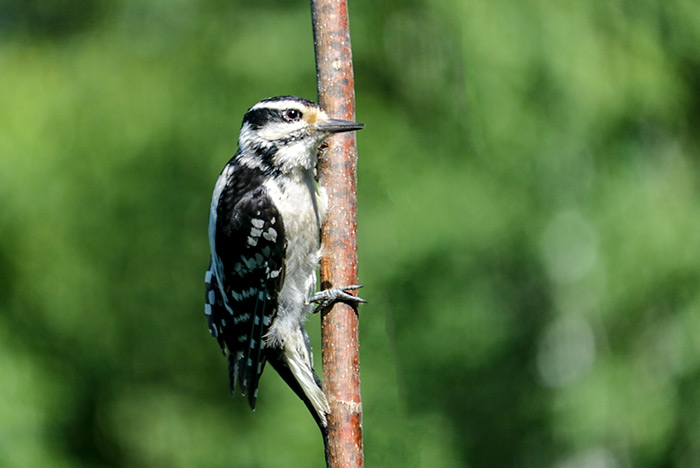
Hairy woodpeckers Leuconotopicus villosus, will make their nests in a dead stub of a living tree. The cavity is often made in a branch or stub with an entrance hole on the underside. Nest making will begin less than two weeks before the start of egg-laying.

Hairy woodpeckers Leuconotopicus villosus will lay from three to six white eggs, laid on a bed of wood chips. These woodpeckers only breed once a season and both the male and female will incubate and care for their young.
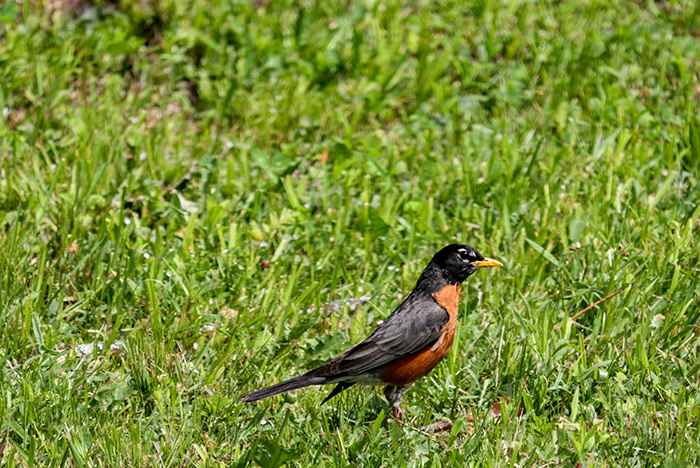
American robins Turdus migratorius, breed from April to July and they will usually have two to three broods per season. Nests are built by the female with some help from the male. They will build their nests in dense bushes or in a fork between two tree branches and sometimes close to human-made structures. A clutch consists of three to seven light-blue eggs and is incubated by the female. Males may help in taking care of the young, while the female builds the next nesting site.

The mating season for blue jays Cyanocitta cristata, begins in mid-March and peaks in mid-April to May, extending into July.

Both male and female blue jays Cyanocitta cristata, will help in building the nest. Nests are built 10 to 25 feet off of the ground in the crotch or thick outer branches of deciduous or coniferous trees. It is cup-shaped and made up of twigs, small roots, bark strips, moss, and other plant material. Other materials include cloth, paper, and feathers, with mud, sometimes added to the nest.
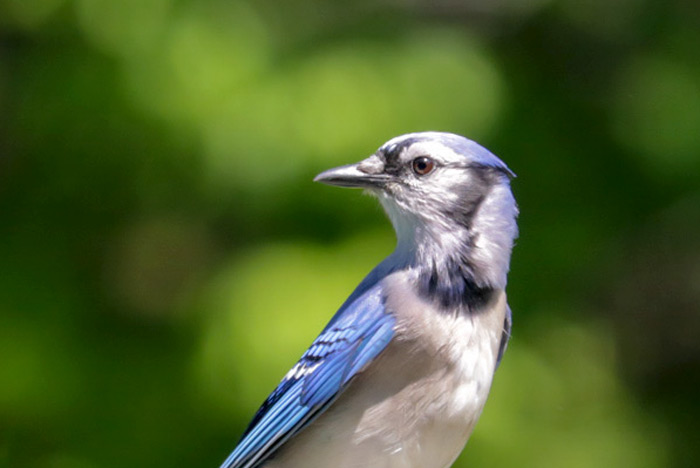
Blue jays Cyanocitta cristata, will typically form monogamous bonds for life. They usually have two to seven eggs that are bluish or light brown with brownish spots. The young will leave 17-21 days after hatching. The family will then forage for food together until fall and then disperse for the winter in order to avoid competition for food.

The American goldfinch Spinus tristis, will begin nesting in July and August. Nests are built in deciduous shrubs or trees or sometimes in conifers or dense weeds. Construction materials include plant fibers, spiderwebs, caterpillar silk, and lined with plants down from thistles, milkweed, or cattail. The nest is built by the female and is a compact cup shape placed in branches at a height of about 30 inches. Nests are so well built, that they can hold water. This may be problematic for the young birds, if not properly covered during construction. They will lay four to six, sometimes two to seven eggs that are pale bluish white, occasionally with light brown spots. Males will feed the females during incubation. Young will leave the nest about 11-17 days after hatching.
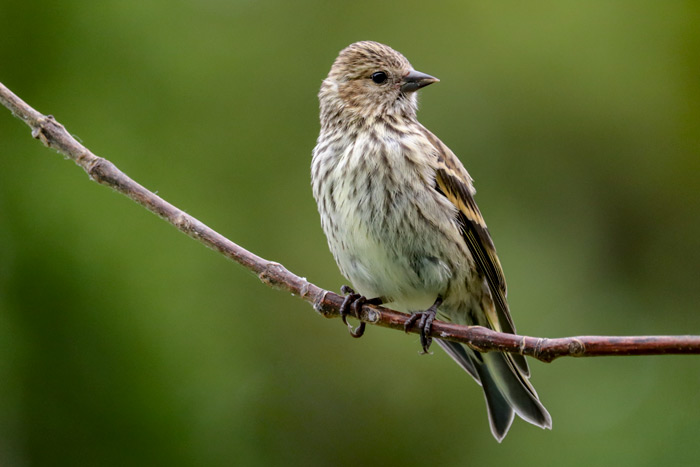
The female pine siskin Spinus pinus will build their nest in a well-hidden tree. This will usually be a conifer on a horizontal branch far from the trunk. The nest is a large, shallow open cup of twigs, grass, strips of bark, and rootlets, lined with moss, animal fur, and feathers. There are three to four, sometimes two to five pale greenish-blue eggs, with brown and black dots often concentrated at the larger end. The female incubates the eggs and the male will feed her during this time. Young will leave the nest about 14-15 days after hatching.
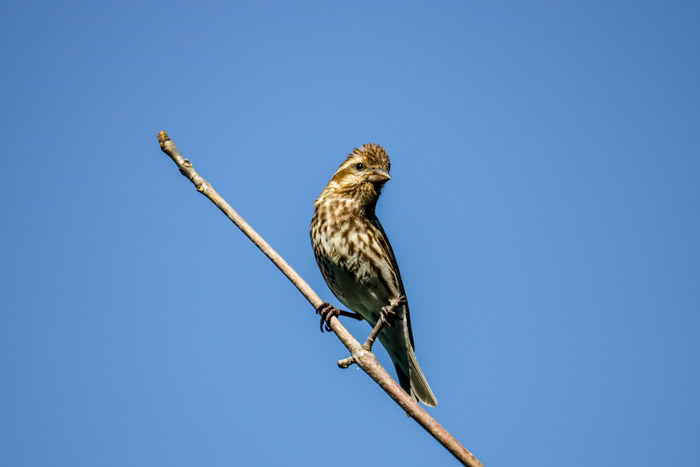
The purple finch Haemorhous purpureus, will build their nests far out on the limb of a coniferous tree or in oaks, maples, and cherries. The female will do most of the nest building from materials such as twigs, sticks, and roots making up the exterior and the interior lined with grasses and animal fur. The clutch size is made up of two to seven eggs that are pale greenish blue in color, marked with brown and black.

The clutch size of the purple finch Haemorhous purpureus is made up of two to seven eggs that are pale greenish blue in color, marked with brown and black.
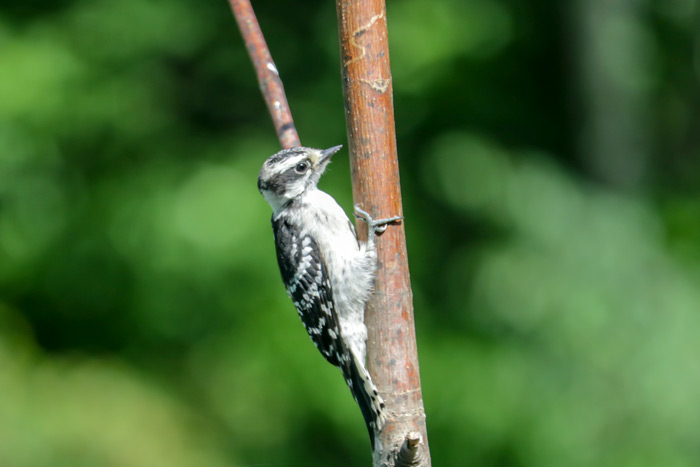
Both the male and female downy woodpecker Dryobates pubescens will excavate a nesting site in a dead limb or dead tree. They have one brood per season, consisting of four to five, sometimes three to six white eggs, that are incubated by both sexes. The young will leave 20-25 days after hatching and will spend many weeks with their parents.

European starlings or common starlings Sturnus vulgaris, breed in the spring and summer. Males attract females by building nests, decorated with flowers and fresh green materials. Later on, females will take the nest apart after finding an acceptable mate. The female lays four to five eggs over a period of several days. Eggs are a glossy pale blue, sometimes white, and ovoid in shape. Starlings also engage in intraspecific brood parasitism, meaning, unpaired females will lay eggs in another pair of starling’s nests. Fledglings may also invade neighboring nests.
Migratory Species
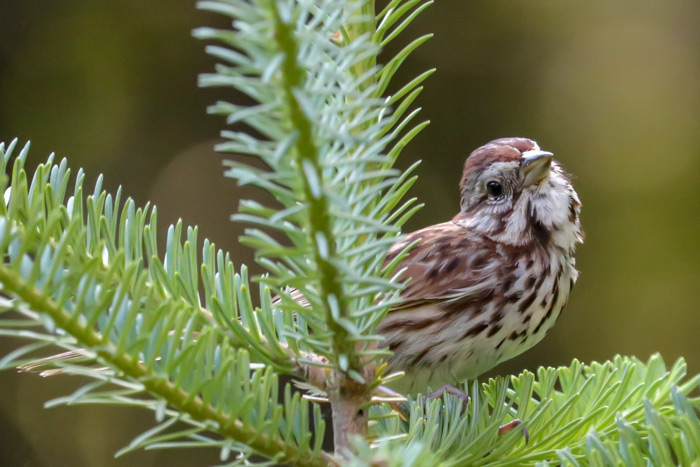
The song sparrow Melospiza melodia, is a resident to medium-distance migratory bird. Northern populations of the song sparrow may migrate to the southern United States or Mexico during winter.
Nesting sites are built mostly by the female and include the ground under a clump of grass or a shrub. Higher nesting sites may be in shrubs, low trees, or marsh vegetation, often above water. Nests are open cups of weeds, grass, leaves, and strips of bark, lined with fine grass, rootlets, and animal fur. There are typically three to five pale greenish-white eggs, that are heavily spotted with reddish brown. Both parents feed their young. Fledglings will remain with their parent for roughly another three weeks.
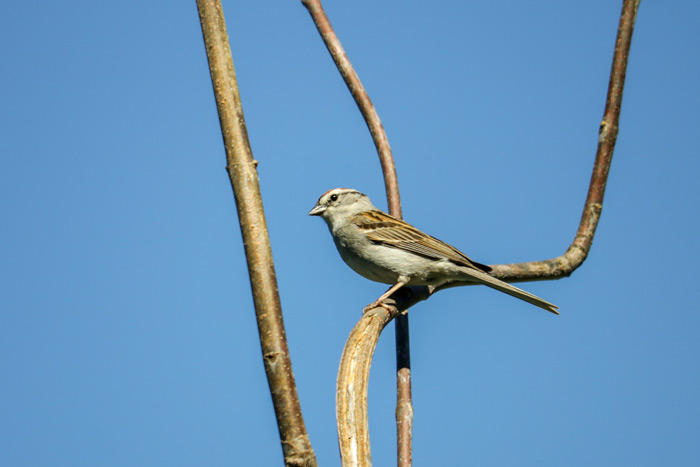
The chipping sparrow Spizella passerina, migrates at night in flocks. Migration is spread over a long period in both spring and fall. They are found throughout Maine in the summer, but they will leave for the southern states, Mexico and Central America in the fall.
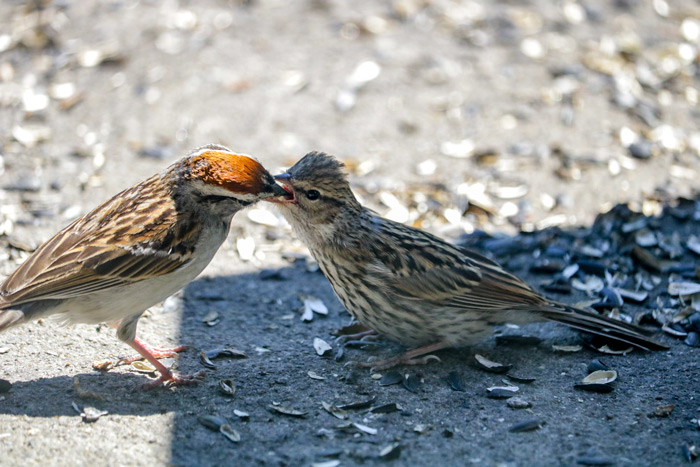
Chipping sparrow Spizella passerina, males will have more than one mate. Nests are built by females and sites include conifers, deciduous trees, or on the ground. The nest is a small open cup made of grass, weeds, and rootlets and lined with fine grass and animal fur. There are usually three to four pale, blue-green eggs with brown, and purple markings and mostly black at the larger end. Both parents participate in the feeding of their young.
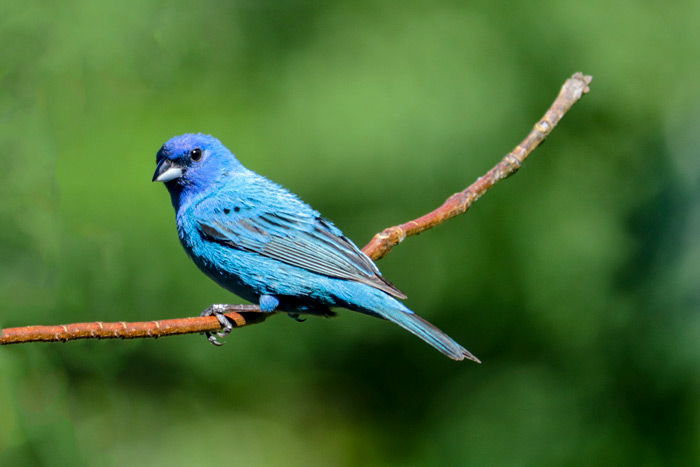
Indigo buntings Passerina cyanea, breed in eastern North America and winter primarily in Mexico and Central America, as well as in the Caribbean and sometimes in southern Florida.
Nests are made in dense shrubs or low trees. The nest is made by the female and materials include leaves, coarse grasses, stems, and strips of bark, lined with soft grass or deer fur, and bound with spider webs. The clutch consists of one to four eggs, but will usually contain three to four. The eggs are white and may be marked with brownish spots. Most breeding pairs will raise two broods per year and the male may feed the newly fledged young while the female incubates the next clutch of eggs.
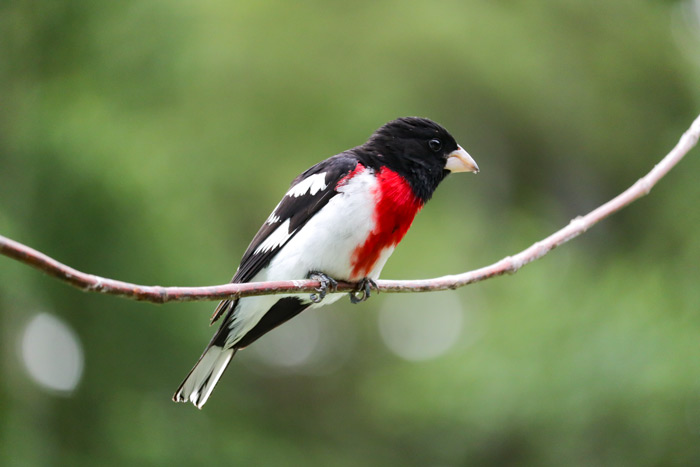
The rose-breasted grosbeak Pheucticus ludovicianus, migrates northward between mid-March and mid-April to breed, from regions of southern Mexico, the Caribbean, South, and Central America. Individuals will then migrate back down south in late September or in October. These birds will arrive until late May, with the males arriving and establishing a nesting territory first, with females arriving later.
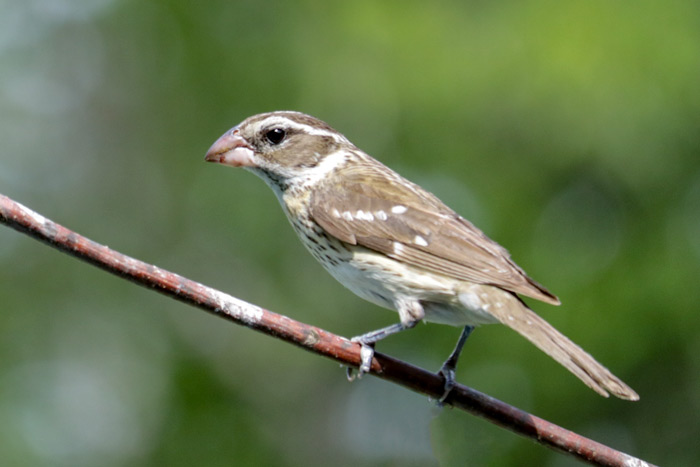
Female rose-breasted grosbeaks Pheucticus ludovicianus, build nests in deciduous trees, large shrubs, and sometimes conifers. The nest is an open cup, loosely made up of twigs, weeds, and leaves, lined with finer twigs, rootlets, and sometimes animal fur. There are typically three to five pale greenish blue, spotted with reddish brown eggs. Both parents feed their young. They will have one to two broods per year and the male may care for the young, while the female builds a new nest.
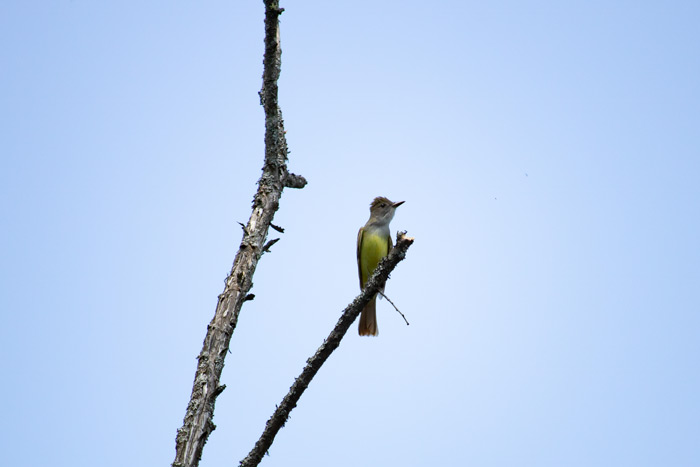
Eastern wood peewees Contopus virens, are one of the last migrants to return in the spring from overwintering in Central America and in the Andes region of northern South America.
Nests are open cup nests constructed of grasses, bark, and lichen, attached to a horizontal tree branch with spider webs. Trees used for nesting include oaks, pines, birches, and maples. Females lay three sometimes two translucent-white eggs with brown flecking toward the larger end of the egg. Parents will perch nearby and keep in contact, providing them with food until the young are able to fly and join them.
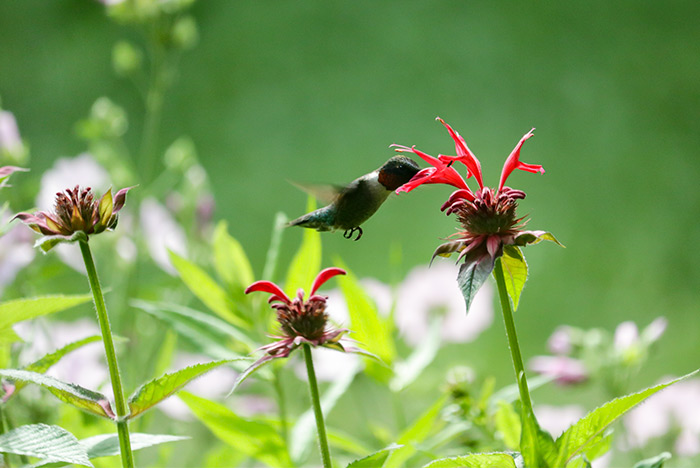
During migration, some ruby-throated hummingbirds Archilochus colubris, will embark on a nonstop 900-mile journey across the Gulf of Mexico and the Caribbean from Panama or Mexico to the eastern United States. During the winter, these hummingbirds may spend most of the winter in Florida, southern Mexico, and Central America.

The female ruby-throated hummingbird Archilochus colubris will build a nest in a protected location either in a shrub or a tree. During courtship, males will fly in a U-shaped “pendulum” arc, or make short passes, while making a low continuous sound in front of a perched female. Nests are built by the female in a tree or large shrub and placed on a horizontal or sloping branch, surrounded by leaves for cover. Construction includes a compact cup of grasses, plant fibers, and spider webs, and is lined with plant down. The outside is camouflaged with lichens and dead leaves. These hummingbirds will lay two white eggs, incubated by the female. They have one to two broods per season, sometimes three. The nest will stretch as the young grow and the female may begin a second nest while feeding the young from the first nest.
Resources used for this post:
allaboutbirds.org & audubon.org
Leave a Reply